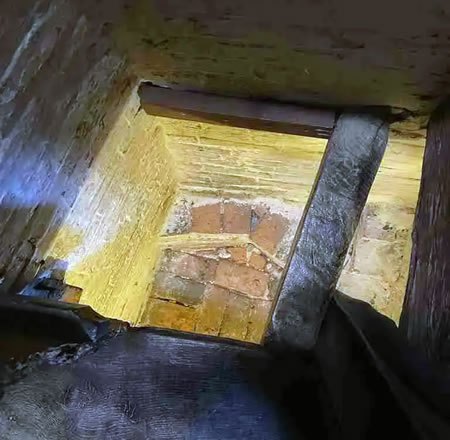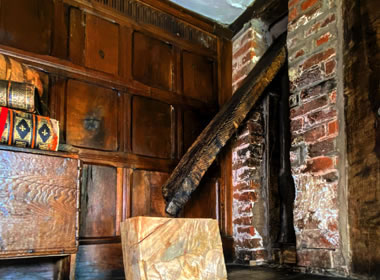
On the night of September 7, 1651, things were looking bad for Charles Stuart, the future King Charles II. Four days earlier, his Royalist army had been destroyed by Oliver Cromwell’s Parliamentarians at the Battle of Worcester, the final engagement of the English Civil Wars (1642- 51). Together with a small group of supporters, he was now on the run. There was a price on his head. The previous day, he’d only escaped capture by hiding in the branches of an oak tree (later to be celebrated as “The Royal Oak”) in the grounds of Boscobel House in Shropshire. The stakes were high — two years before, his father Charles I had been publicly beheaded in London.
For the desperate fugitives, there appeared to be one last chance of safety. The persecuted English Catholic minority had sided with the Crown in the Civil Wars, and close by in Staffordshire (dubbed “Little Rome” for the number of its Catholic houses) lay Moseley Hall. This was owned by the Catholic Whitgreaves. Moreover, this family was clandestinely served by a priest, a Benedictine monk called Fr. John Huddleston, who lived there disguised as a servant. As Charles later recalled to the diarist Samuel Pepys, they were “Roman Catholique, and I chose to trust them, because I knew they had hideing-holes for Priests, that I thought I might make use of in case of neede.”

Under cover of darkness, five brothers from the Penderel family — Charles’s “five faithful” — brought the prince to Moseley mounted on an old mill horse. (When Charles complained about the discomfort of his mount, Humphrey Penderel allegedly replied, “My liege, can you blame the horse to go heavily when he has the weight of three kingdoms on its back?”)
The bedraggled future monarch of England, Scotland, and Ireland stumbled into Moseley in the early hours of September 8, to be received by Thomas Whitgreave, Thomas’s mother Alice and Father Huddleston. These were to be the only three members of the household privy to the mystery visitor’s true identity. Even loyal servants were informed that the man was just another hunted Royalist. Huddleston immediately conducted Charles to his own first-floor room. This had a clear view of the approach road and was accessible by a back staircase. Crucially, it had another advantage. Next to the fireplace was a wardrobe and, under its floor, a trapdoor leading to one of the famous “priest holes.” It had served Huddleston well for many years. Now it was to save the life of a king.
Charles’s taking refuge at Moseley had come not a moment too soon, for Cromwell’s Roundheads were hot on his heels. On only his second day at the house he heard the dreaded cry, “Soldiers are coming!” He was immediately bundled into the priest hole, where he lay low until the troopers had left. Looking at it now, you can only imagine how claustrophobic it must have been, yet as Charles later remarked tongue-in-cheek to Pepys, it was “the best place he was ever in.”
Next to the fireplace was a wardrobe and, under its floor, a trapdoor leading to one of the famous “priest holes.” It had served Huddleston well for many years. Now it was to save the life of a king.
Charles had evaded capture by the skin of his teeth, but he and his hosts knew their luck couldn’t last. The soldiers would be back. So, the day after, they arranged for a courageous Protestant Royalist, Jane Lane, to take Charles with her to Bristol disguised as her servant, under the pretext of visiting her sister who lived in that city. It was from Bristol that Charles made it to the South Coast and, eventually, from there to France.
Nine nervous years lay ahead for those who’d assisted in his escape. However, the story had a happy ending. Or rather, several happy endings. Cromwell died in 1659, and in 1660 Charles was finally restored to the throne as Charles II.
The Whitgreave, Penderel and Lane families were all richly rewarded. As for John Huddleston, he was summoned to London, housed in Somerset House, granted immunity from prosecution and installed as Royal Chaplain, first to Charles’s Catholic mother Queen Henrietta Maria, and then to his Portuguese Catholic wife Queen Catherine of Braganza — the only Englishman ever to be accorded that honor. But the tale doesn’t even end there.
Inspired in no small part by the courageous examples of those Catholics who’d sheltered him after Worcester, Charles long considered becoming a Catholic himself, but political considerations made it impossible. Then, on the morning of February 2, 1685, he fell gravely ill. Knowing he was dying, he quietly conferred with his Catholic brother James (later King James II). Once the Protestant clergy had been ushered out, up the back stairs came a Catholic priest, who gave Charles the Last Sacraments and received him at last into the Catholic Church.
That priest was Father John Huddleston.
Columban Fr. John Boles lives and works in Britain.
Priest Holes

Today, when we hear of Christians being persecuted for their beliefs, it is sobering to remember that there was a time when Catholicism in Britain was outlawed. Under Elizabeth I and James I it was treason for a priest to celebrate Mass, and for lay people to shelter him. For this reason, wealthy Catholic families often built concealed “priest holes” into their houses. Many were designed by Jesuit lay brother St. Nicholas Owen, who died in the Tower in 1606. The future Charles II sheltered in one such refuge at Moseley Hall.
Nearby Harvington Hall in Worcestershire contains the best examples of these priest holes. So well concealed were they that some were only discovered in later centuries. In one room stands an innocentlooking fireplace complete with ash stains. Look more closely, and the “ash stains” turn out to be black paint. Crawl up the chimney breast and you find it blocked off — but with boards that can be removed, leading to a bolthole in the roof.
Harvington Hall, like any self-respecting Elizabethan manor, boasts a library with a large book cupboard. “But,” explains a guide, “if you know where to press, one of the wall timbers suddenly swings out on a pivot,” acting as a door to another secret chamber.